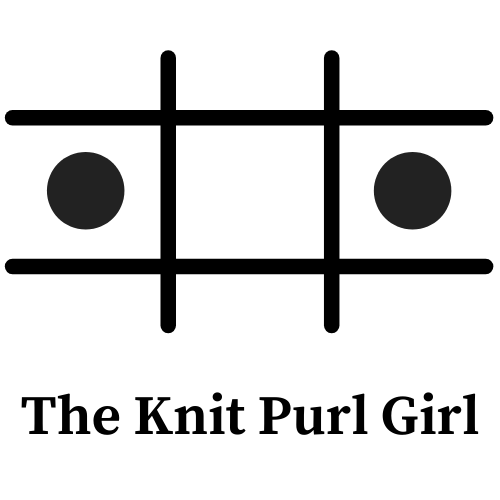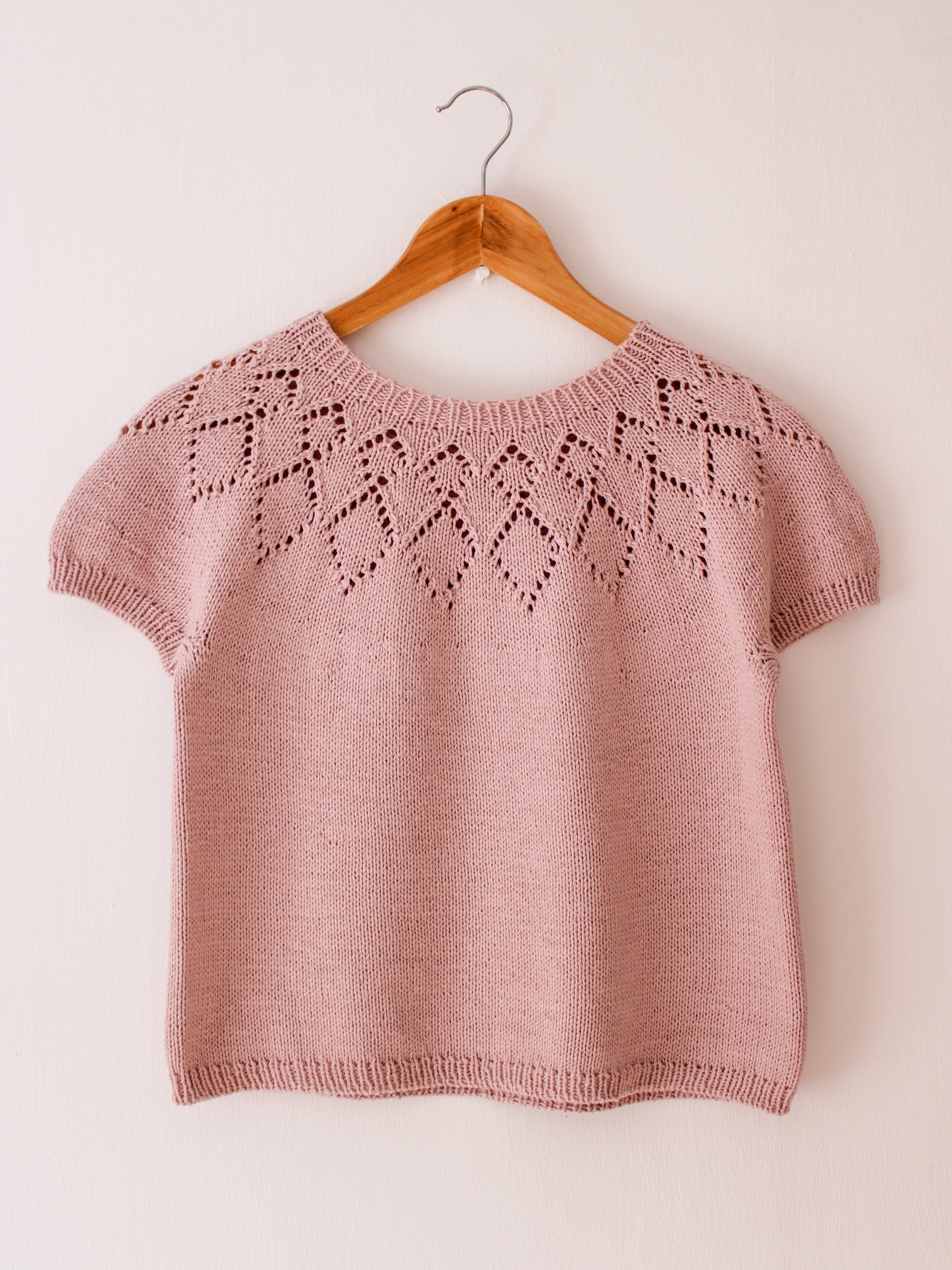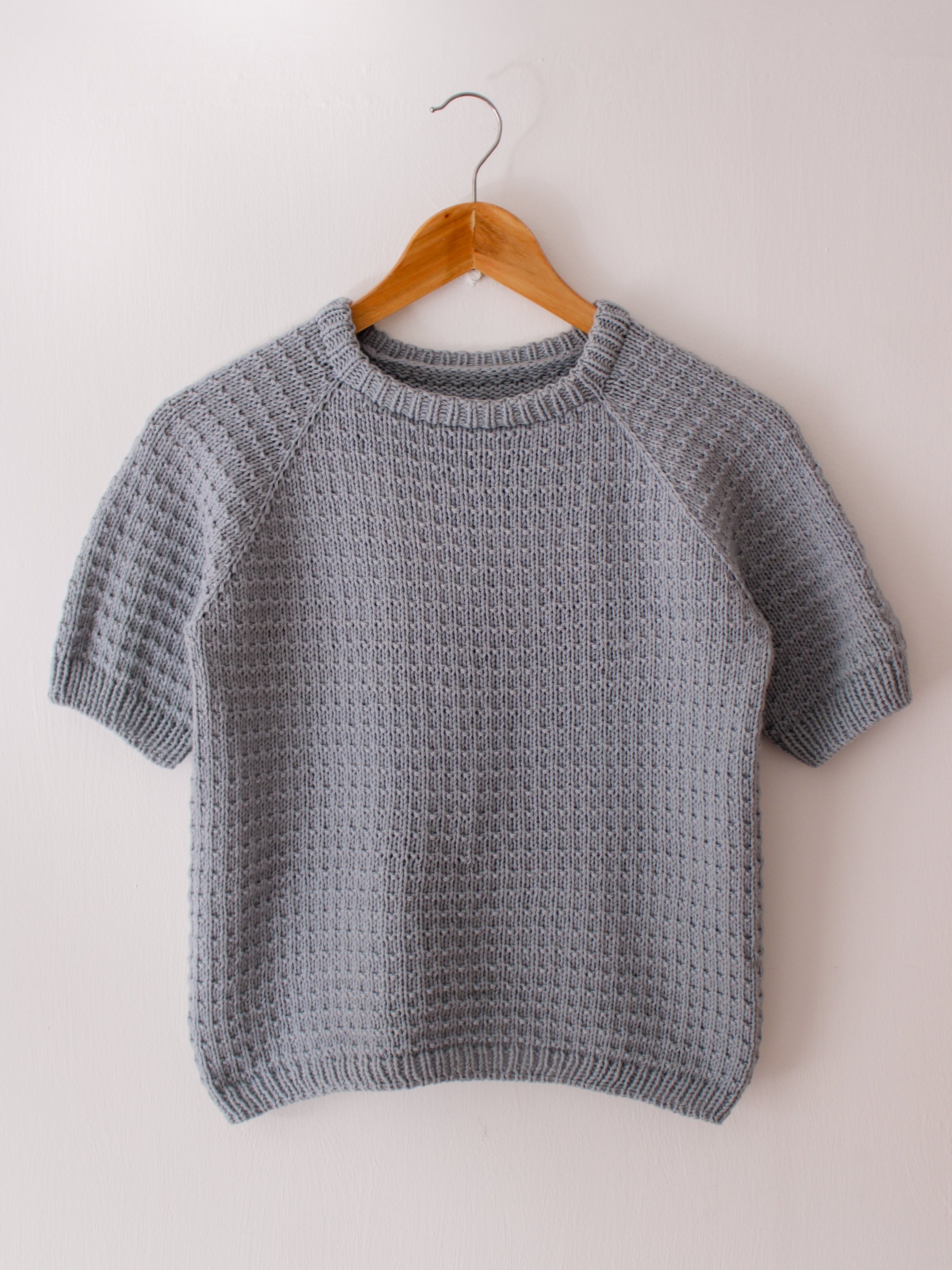Farfa Top
The Farfa Top is a feminine and modern t-shirt, perfect for warm summer days. It is primarily worked on 3.5 mm needles, but you will also need a 3.25 and 3 mm needle. The design includes a voluminous – dare I say, flouncy – sleeve, with hemming along the sleeves and bottom of the Top. The neckline is finished with an i-cord which fastens the keyhole detail at the back of the neck. The design also features short rows around the back and shoulders.
I made the first sample garment bottom-up but, for various reasons, the second sample garment is worked top-down, as is this pattern. It makes the short row shaping easier and it is easier to adapt the pattern to get the best fit for you when it is worked top-down. Please therefore note that the red Farfa Top in the images differs slightly from the final pattern, though the stitch counts and overall fit is identical.
There are two different options for the sleeves. The first, seen in the red sample garment, has a single set of increases creating a single-tier frill. The second, seen in the blue sample garment, has two sets of increases creating a double-tier frill. The single-tier option is better for those who want a more voluminous sleeve, as this option is a bit lighter. However, the double-tier option is just as flattering and sits a bit longer and heavier, feeling very luxurious to wear.
Please note that this is a pdf copy and not a physical pattern.
The Farfa Top is a feminine and modern t-shirt, perfect for warm summer days. It is primarily worked on 3.5 mm needles, but you will also need a 3.25 and 3 mm needle. The design includes a voluminous – dare I say, flouncy – sleeve, with hemming along the sleeves and bottom of the Top. The neckline is finished with an i-cord which fastens the keyhole detail at the back of the neck. The design also features short rows around the back and shoulders.
I made the first sample garment bottom-up but, for various reasons, the second sample garment is worked top-down, as is this pattern. It makes the short row shaping easier and it is easier to adapt the pattern to get the best fit for you when it is worked top-down. Please therefore note that the red Farfa Top in the images differs slightly from the final pattern, though the stitch counts and overall fit is identical.
There are two different options for the sleeves. The first, seen in the red sample garment, has a single set of increases creating a single-tier frill. The second, seen in the blue sample garment, has two sets of increases creating a double-tier frill. The single-tier option is better for those who want a more voluminous sleeve, as this option is a bit lighter. However, the double-tier option is just as flattering and sits a bit longer and heavier, feeling very luxurious to wear.
Please note that this is a pdf copy and not a physical pattern.
The Farfa Top is a feminine and modern t-shirt, perfect for warm summer days. It is primarily worked on 3.5 mm needles, but you will also need a 3.25 and 3 mm needle. The design includes a voluminous – dare I say, flouncy – sleeve, with hemming along the sleeves and bottom of the Top. The neckline is finished with an i-cord which fastens the keyhole detail at the back of the neck. The design also features short rows around the back and shoulders.
I made the first sample garment bottom-up but, for various reasons, the second sample garment is worked top-down, as is this pattern. It makes the short row shaping easier and it is easier to adapt the pattern to get the best fit for you when it is worked top-down. Please therefore note that the red Farfa Top in the images differs slightly from the final pattern, though the stitch counts and overall fit is identical.
There are two different options for the sleeves. The first, seen in the red sample garment, has a single set of increases creating a single-tier frill. The second, seen in the blue sample garment, has two sets of increases creating a double-tier frill. The single-tier option is better for those who want a more voluminous sleeve, as this option is a bit lighter. However, the double-tier option is just as flattering and sits a bit longer and heavier, feeling very luxurious to wear.
Please note that this is a pdf copy and not a physical pattern.
Gauge: 27 stitches x 34 rows in stocking stitch on 3.5 mm needles = 10 x 10 cm
Materials & Fit
Notions: 3.5 mm (40, 60 and 80 cm cord; a 100 cm cord may also be useful for sizes C and up), 3.25 mm (60 and 80/100 cm cord) circular needles, and 3 mm (60 and 80/100 cm cord) circular needles. Feel free to adjust your needle size up or down accordingly, working in 0.25 mm increments. I have relatively tight row gauge compared with most knitters, but it isn’t too important for this project.
You will also need at least 9 stitch markers, one of which should be in a contrasting colour to indicate the beginning of the round, a darning needle, and some spare needles/scrap yarn/stitch holders where the stitches of the sleeves will rest. I would also recommend having some extras on hand to make keeping track of the row count easier.
Yarn: Approximately 1,000 (1,000) 1,000-1,250 (1,250) 1,250-1,500 (1,500) 1,500 (1,500-1,750) 1,750 (1,750) m, or 4 (4) 4-5 (5) 5-6 (6) 6 (6-7) 7 (7) skeins of Pure Silk from Knitting For Olive (50 g = 250 m). Both samples were made in Size C and used 4 skeins in total, but I am relatively short in the torso for my height (5’4”) and some testers of the same size needed an extra skein.
Sample 1 was knitted in the shade Gooseberry Red and Sample 2 was knitted in the shade Dove Blue.
Yarn alternatives: Any fingering-weight yarn with a good amount of drape will be beautiful. If you are looking for a vegan-friendly option, DMC Natura Linen Yarn is a great option (50 g = 150 m), as is Sandnes Tynn Line (50 g = 220 m). If you’re okay with the top having a bit more heft to it, something like We Are Knitters Bamboo (100 g = 350 m) might be good, though I am told that this yarn is prone to growing as it is a bit more dense than the yarn I used to make the samples, but I think it would still be quite lovely. Ideally, you’ll use something with a bit of texture.
Sizing and ease: The Farfa Top has about 5-10 cm positive ease for sizes A-G, and 5-15 cm positive ease for sizes H-J. If you would like a closer fitting or looser garment, size up or down accordingly. Some testers of this pattern added waist shaping and although this is not a feature of the pattern, I have included their notes here should you wish to use them as a guideline to create a more fitted look. Use the chart below to find the best size for you based on your chest measurement.
Size: A (B) C (D) E (F) G (H) I (J)
Chest measurement (cm): 80-85 (85-90) 90-95 (95-100) 100-105 (105-110) 110-115 (115-125) 125-135 (135-145)
Actual circumference of garment (cm): 90 (95) 100 (105) 110 (115) 120 (130) 140 (150)
Techniques: This pattern calls for German short rows, knitted hems, various increases, and working both flat and in the round.






















